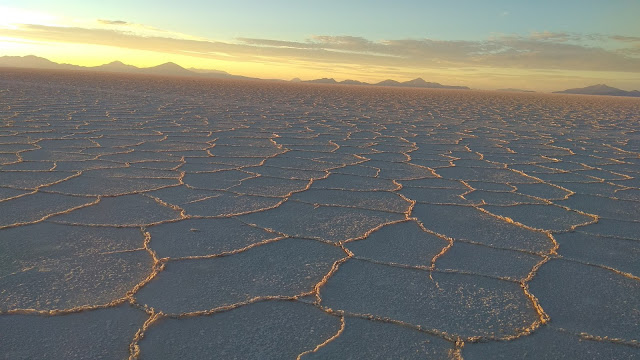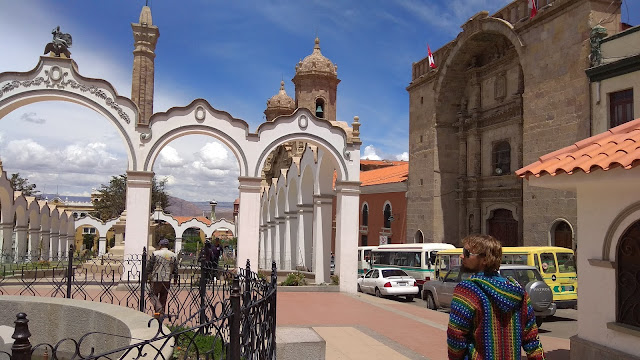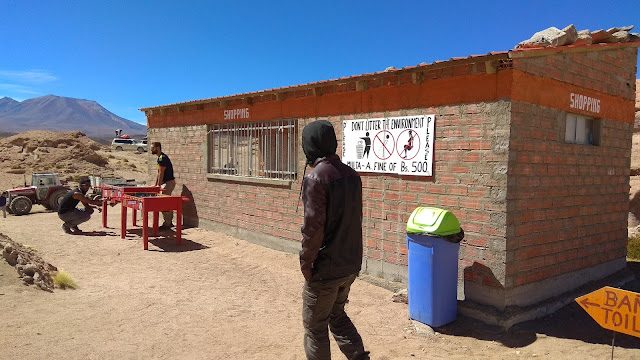Since we do have a bike we decided to go back on the salt flats once more to camp and meet Lucy. We stayed on a small private island and made bonfire of cactuses and small bushes (this has nothing to do with normal campfire as they contain some strange substances that burn very brightly, with high flames and with the smell of burning rubber) . It is quite amazing to see the sun going down behind other islands, changing the colour of the salt which looks exactly like ice, except it is is divided into six-sided shapes as far as you can see (and during the sunset all the edges of the hexagons are lit up) and it is incredibly dry there as well. But I do think it is the coolest place we have ever camped.
The next day we drove off the salt and took a small road around a volcano, called Thunupa, to get back to the main road. We had passed a few villages (most of the houses abandoned and roof-less) when we drove past a group of people in traditional clothes holding beer bottles who were waving at us to join them. The very traditional ones are usually not very interested in tourists so we decided to go and see what they want, thinking that surely it was a kind of market and they want to sell us something. But surprisingly that was not the case.
 |
| The men's altar with the remains of the sacrificed sheep |
What we were invited to was actually a very traditional celebration (they claimed that we were the first foreigners who had ever stopped and taken part) of giving the power of last year's leaders to the next ones. So the most important elders of the area (of the Thunupa vulcano) spend a week each year walking from village to village to transform the power (cambio de poder).
When we joined in, they had already sacrificed a sheep (it was cooking on the fire) and they were drinking to the Pacha Mama (mother earth), Thunupa and the milk of Thunupa (the Uyuni salt flat, which was called Salar de Thunupa by the locals). You were supposed to be poured the drink (beer at first) by someone else and every time before drinking, some of it had to be sacrificed to Pacha Mama and Thunupa as well.
Smearing salt behind the ears, singing and dancing were also involved. And everyone had their own cannister of moonshine - drinking which was another part of the tradition - giving good wishes to others of course while doing so. Which meant some more pouring alcohol on the ground and drinking the rest of it. The elders also passed on good luck by slapping others on the butt three times with a cow's whip and then giving out candy. And of course the sacrificed sheep was eaten with rice and coca leaves chewed.
 |
| In South America I am tall for the first time in my life |
After we had taken part in everything, we were obviously not capable of going anywhere by the bike (all the beer and moonshine) so after the elders left, we stayed behind in the small village of only five families and were hosted by the 'president of the village' who was extremely proud when he got a sound out of the didgeridoo we are traveling with. From him we also heard a lot about the attitudes towards Europeans, that I will talk about shortly.
 |
| Abandoned houses between Thunupa and the Salar of Uyuni |
I mentioned the elections and the president in the last post. When the results came out, about 85% of Bolivians had voted BUT over 65% of them had ruined their ballots to show their feelings towards the government. Now why did they do that? Evo Morales is the first Bolivian president, who is indigenous and that's why a lot of people actually support him (plus he HAS done good things for the growth of the economy in general) . He is a former coca farmer as well.
Now one of the problems is that he didn't stop being the head of the coca farmers' association when he became the president. And everyone knows that he is doing his best to develop the business of cocaine as well. For example he built a new 'international airport', but so far no international flights have gone in or out. Don't get me wrong - there are flights all the time, they are just not the most official kind, if you know what I mean.
When he came to power, the president was allowed to rule for just two terms. He is right now on his third term. Last year he organised a census to get people's approval to abolish these restrictions (so that he could be the president for even longer), but the people didn't give him the permission. So this year he changed the law so that he is also the head of the juridical system (the courts) and surprise-surprise, the higher court decided a few weeks ago that there are no more limits as to how many terms a president can rule.
There are other things that he has done and not done, so as a result people wanted to show their disappointment. Evo himself of course claims that this is all the work of the United States and the opposition (they were the ones who encouraged the people to ruin the ballots but well... the people ruined the ballots all by themselves) and did not annul the results of the elections (they were actually electing the jurors right now from the choice of candidates that Evo had chosen for them). So Evo is blaming all bad things on the USA, the colonists and the Europeans in general.
There are other things that he has done and not done, so as a result people wanted to show their disappointment. Evo himself of course claims that this is all the work of the United States and the opposition (they were the ones who encouraged the people to ruin the ballots but well... the people ruined the ballots all by themselves) and did not annul the results of the elections (they were actually electing the jurors right now from the choice of candidates that Evo had chosen for them). So Evo is blaming all bad things on the USA, the colonists and the Europeans in general.
All over the country there are random walls and surfaces with writings like "vota SI" or "Evo Si", which are mostly done with the same shade of paint. There are many brick walls erected just for the purpose of this "election campaign", which is supposed to look as if common people have done it themselves to show their support.. There are also many places where the Si-campaign has been painted over with the no-campaign.
 |
| Election campaign with additions |
Now traveling around here we have met several people who also blame all of the problems in the country on Americans and Europeans. And most people actually believe that - the Europeans and gringos (who are all one big gang with not many differences) are the main problem. The governments have done a good job brainwashing the people because of course the terrible corruption and laws that harass people on the day-to-day bases have nothing to do with the situation in the countries (remember how poor people are actually not let into schools if they don't have enough money for uniforms. they are not let into hospitals either, in addition to other laws that make sure that not everyone has equal rights).
Well... Estonia became independent much more recently than South American countries and had basically nothing to start with either (everything had been taken out to Mother Russia, many intellectuals killed or taken to Siberia) but instead of whining, they have actually become quite a good country (if only the salaries caught up with the prices). And it feels completely unfair that we are being punished for what some colonial countries have done to this continent (for example we are paying several times higher price for many things). But a white is a white and is a cocky, rich, colonising bastard for many locals.
What is even more upsetting is that we actually spent a whole year working our asses off in Australia , often doing 6-day work weeks with 12+ hours a day because we wanted to come and see the amazing South America. When we go back home we will be as poor as before, with nothing left, my most valuable possession being my 15-year-old bicycle. And now we get racism and horrible attitude towards us on a daily bases (in some areas more, in others a bit less) . No matter how much we explain, we will always be gringos (I, personally am offended by places with names like HolaGringo that have outrageous prices or restaurants with two sets of menus, according to your continent of birth and skin color). The fact that Estonia has been conquered and ruled by other countries for most of the history (and our culture or country has had zero effect on the troubles of South America) means nothing around here. And they do not even care. So why should we stay here and be punished day after day for our skin color? Most of the above is based on the attitudes in Bolivia, but also of Brazil and Paraguay. And for some reason I don't expect much better in the following countries - Peru, Equador and Colombia... if we don't get totally pissed off earlier and decide that, Fuck it - we have better things to do with my time and last money than to be mistreated every single day (on some days it bothers us more, on others, we manage to ignore it more).
I really do think that most of the problems come from within. People are rude to us (and each others), with service coming without a hint of a smile and doors being slammed in our faces. The people don't care about other people, the most obvious example being cars stopping/parking in the middle of the streets, blocking two-three lanes of traffic and making everybody wait for them. The same goes for service - you can stop for a chat with a friend for ten minutes even if there is a client waiting to get back the change from the buy that has already taken ten minutes (for one bottle of water). The poorness is no excuse, as we have been to South-East Asia and experienced that poor people can also be nice and friendly and cheap foods can be healthy and tasty. Bolivia (South America?) will not develop anywhere before they start looking at themselves and stop blaming everyone else. Yes, you had a rough past. Most of countries in the world have. Now start looking into what could be done to better the country in the present.
We finally made it to the capital of Bolivia (drove through a corner of a thunder/hailstorm with lightning repeatedly striking less than 100m from us to get there) which was called "The worst capital in the world" by Jeremy Clarkson and also badmouthed by many others (it is also the highest capital in the world) . But for us it was a breath of fresh air with all its opportunities like supermarkets for finding fresh refrigerated ingredients (usually the cheese and meat are just lying openly on benches surrounded by a mob of flies) and even restaurants with chinese food in addition to everything else that can be found in the city's big markets and endless streets.
The center of La Paz is located at a bottom of a deep valley (with quite steep sides), so the view over the city that you get before entering it, from the edge of it, is just amazing. It is a big valley filled with red brick houses on all the slopes. There are cable cars connecting many parts of the city, giving amazing views over the city and costing less than a dollar. Very soon, when they finish building the last few lines, you can go all around the city with them and also to the neighbouring city, el Alto (in translation the hight/high) that lies on the edge of La Paz.
 |
| This is NOT a market day in El Alto |
Now of course it is still Bolivia that we are talking about so when we first arrived, it was a big effort to get to the other wide of center to our hotel. The resin being that there was a big Christmas carnival happening on the day that we got there so all the centre was closed (we discovered that it was closed down for different reasons on exactly half of the days that we spent in La Paz). So all the traffic was directed to the small side streets , which were all pretty steep, going up and down, often covered in wet cobblestones (it was slightly raining on the day of our arrival). Of course all the roads are one way, usually going the wrong way for us and having hidden signs to indicate the direction. And the streets were full of market stalls and people and cars stopping in the middle of the road. Erik was signaling and cursing every time we had to stop again on these wet slopes every time a minibus decided to stop in the middle of the road again (even if there was time to get out of the way) to chat with a friend or pick someone up (which happened every 30 seconds or so) . They also drive out to the intersection even if there is clearly nowhere to go on the other side of it, blocking off all the traffic to everyone from the other directions as well. So when we finally made it to our hotel two hours later and brought our bike inside, the whole hotel was filled with the smell of our burning clutch.
We mostly avoided using our bike in the city after that so luckily we avoided being pissed off at every single imbecile driver (they really don't understand the concept of considering others in traffic). Almost the only time that we did use it was to visit pre-incan archeological site of Tihuanaku/Tiwanacu 40km out of town, where they have found pyramids and big monolith statues of Pacha Mama and other human-like creatures. Quite cool stuff that has been built really long time ago.
Our last stop in Bolivia is at Copacabana, a small touristic town on the shore of Lake Titicaca (the highest navigable body of water, lying 3800m above sea level) which is also the biggest body of water we have seen since leaving Chile five months ago (and it is also the biggest lake in South America) . It is lovely, for some reason cheaper than any other, touristic town, were my my main aim is eating as much Trout as I possibly can during the time spent here (there are also many other choices when it comes to food AND someone has taught them about seasoning around here as well, which is great).
 |
| Every vehicle going to Copacabana crosses water with one of those ridiculously primitive "ferries" |
The hillsides around the area have all been turned into steps to make fields by the Incas, which looks pretty picturesque. Right now only a fraction of the fields are being used for some reason, although the climate is the nicest we have met in a while (the air was really dry everywhere around the salt flats) and surely the Incas didn't go through all the trouble if the land was not usable for growing stuff.
We also took a boat trip to the two islands near here, also covered in the same steps. For anyone doing it in the future, I recommend skipping Isla de la Luna and instead spend more time on Isla del Sol as the boats are incredibly slow. When visiting both islands on one day (like we did) , you end up sitting most of the day in the boat and then running through the main attraction, where there is really a lot to see.
 |
| I think there were more boats for tourists to hire than tourists (low season) |
So the next step for us is to try crossing the border with Peru, which is always a gamble considering that our bike officially belongs to some Paraguayan dude. But if we do get it over, we might buy a bigger engine to get up hills a bit easier.
Update: We have successfully crossed the border to Peru despite all the inquiries about any proof of actually buying our motorbike. We have absolutely none. So in order to get out of Peru, we have to fake these papers (actual suggestion by the border-guy)
Update: We have successfully crossed the border to Peru despite all the inquiries about any proof of actually buying our motorbike. We have absolutely none. So in order to get out of Peru, we have to fake these papers (actual suggestion by the border-guy)

















































